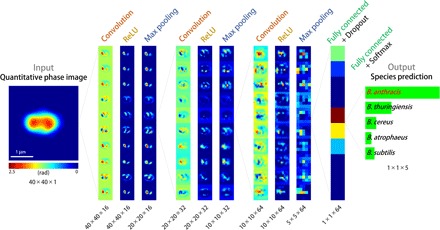Fig. 2. Architecture of HoloConvNet.

When a phase image of an individual spore is taken as the input, the network first processes the images through three rounds of convolution, ReLU nonlinearity, and max pooling layers. Then, two fully connected (and ReLU) layers follow: (i) the last hidden layer under dropout regularization and (ii) the output layer with the class scores. These scores are used to calculate the loss function and to make species predictions in the training and test stages, respectively. Only 10 two-dimensional activation maps per layer are presented with layer-wise scaling for visualization (see table S2 for detailed architecture).
